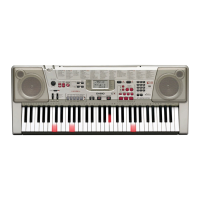Why can't I record chord accompaniment data on my Casio LK-94TV Electronic Keyboard to a computer?
- UunewmanSep 10, 2025
If you cannot record chord accompaniment data on a computer, the ACCOMP OUT may be turned off. Turn on ACCOMP OUT.

Why can't I record chord accompaniment data on my Casio LK-94TV Electronic Keyboard to a computer?
If you cannot record chord accompaniment data on a computer, the ACCOMP OUT may be turned off. Turn on ACCOMP OUT.
Why do lyrics not appear on my Casio Electronic Keyboard?
If lyrics do not appear, it's because the built-in tune or the SMF data does not have any lyric data. Select a built-in tune or SMF data that has lyric data.
Why is the color of the image on the TV screen abnormal when connected to my Casio LK-94TV Electronic Keyboard?
If the color of the image on the TV screen is abnormal, the keyboard is likely located on top of or too close to the TV. Move the keyboard away from the TV.
Why is the image unclear when my Casio Electronic Keyboard is connected to the TV?
If you can hear the audio but the image is unclear, the keyboard and TV are not connected correctly. Correctly connect keyboard and TV.
| Brand | Casio |
|---|---|
| Model | LK-94TV |
| Category | Electronic Keyboard |
| Language | English |
Explains DANGER, WARNING, CAUTION symbols for user safety.
Detailed instructions for battery insertion, safety, and warnings against misuse.
Precautions for using the AC adaptor, cord care, and preventing electrical shock.
Steps to mitigate risks from smoke, overheating, and battery explosions.
Guidelines for preventing injury from dropping, impact, and plastic bag misuse.
Details on tones, rhythms, lessons, karaoke, and song memory.
Identification of MIC VOLUME, KEY CONTROL/TRANSPOSE, PLAY/STOP, KARAOKE buttons.
Identification of SETTING, REVERB/CHORUS, SONG MEMORY, KEY LIGHT, RHYTHM, TONE buttons.
Identification of LESSON PART, METRONOME, SPEAK, PRACTICE PHRASE, STEP buttons.
Identification of PLAY/STOP, TEMPO, SONG BANK, PIANO BANK, SPLIT, LAYER buttons.
Details on USB, VIDEO OUT, SUSTAIN/ASSIGNABLE, DC 9V, and PHONES/OUTPUT jacks.
Guidance on how to play along with lessons, including note and key light instructions.
Instructions for loading batteries and critical safety warnings for battery use.
Guidelines for using the AD-5 AC adaptor and its connection.
Connecting headphones, speakers, and audio equipment via output jacks.
Connecting a microphone and viewing lesson/lyric data on a TV.
Procedure for selecting and changing tones from the instrument's library.
Step-by-step instructions for choosing and playing songs from the Song Bank.
Procedure for accessing and playing tunes from the Piano Bank.
Overview of the 3-step lesson system and how to monitor progress.
Explains Step 1 (timing), Step 2 (notes), and Step 3 (normal speed) of the lessons.
How the evaluation mode assesses performance with points and feedback.
Using tone changes and simulated voice for learning feedback.
Guide to checking evaluation results for Step 1 of the lesson.
Steps to master tunes using lesson features and performance evaluation.
Guide to checking evaluation results for Step 2 of the lesson.
Process for evaluating Step 1 play, understanding results, and identifying weak areas.
Process for evaluating Step 2 play, including key lighting guidance.
How to play tunes at normal speed after completing lesson steps.
Guide to checking evaluation results for Step 3 of the lesson.
Instructions for connecting a microphone and setting its volume.
Step-by-step guide to activate and use the auto accompaniment.
Introduction to Song Memory for recording lessons and performances, including capacity.
Detailed steps for recording keyboard performances.
Steps required to install the USB MIDI driver from the bundled CD-ROM.
Connecting the keyboard to a computer using a USB cable for data transfer.
Step-by-step guide to diagnose and fix problems related to no sound output.
Identifying and resolving common issues encountered when using battery power.
Guidelines for protecting the keyboard from environmental factors and proper cleaning methods.